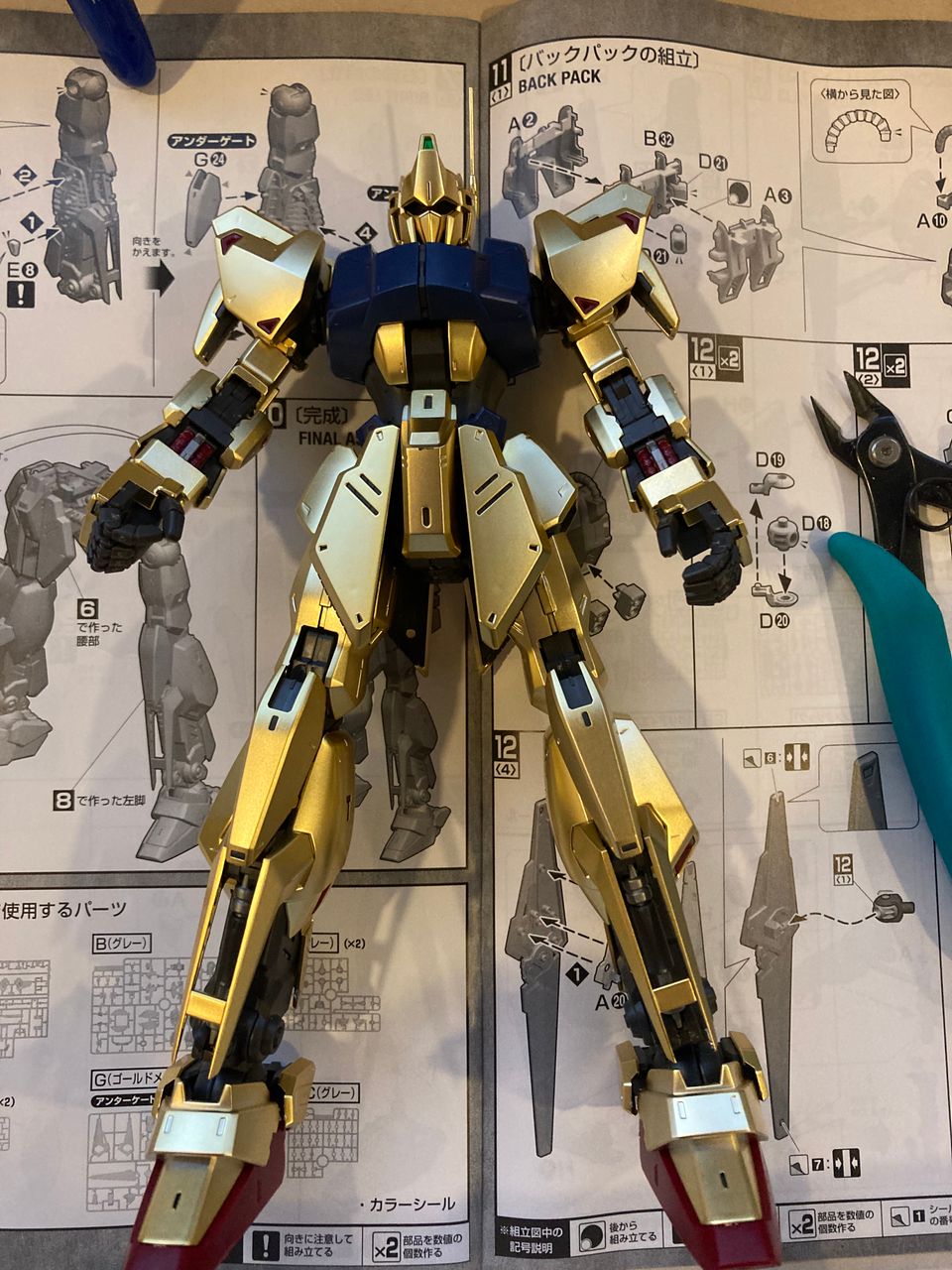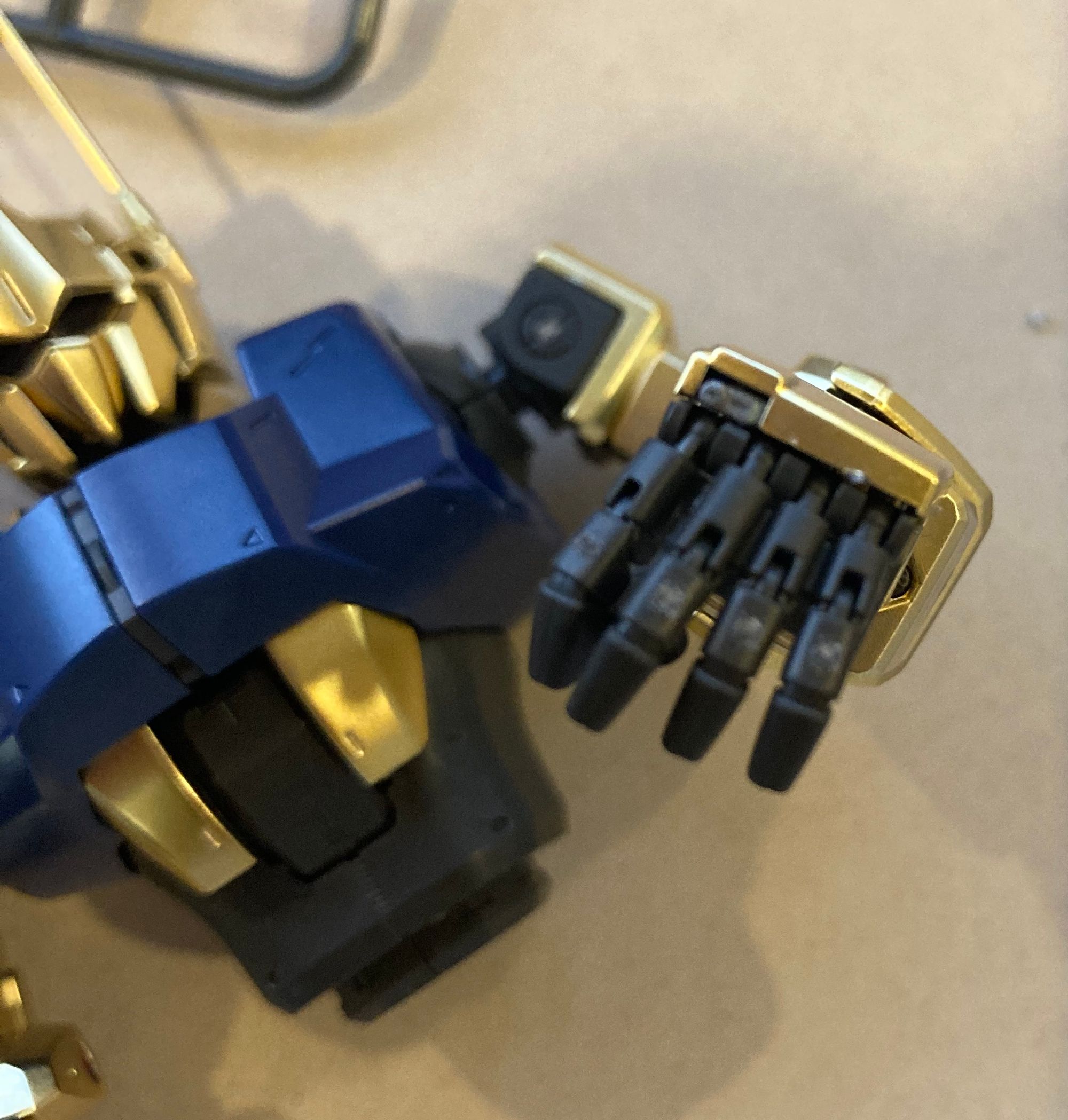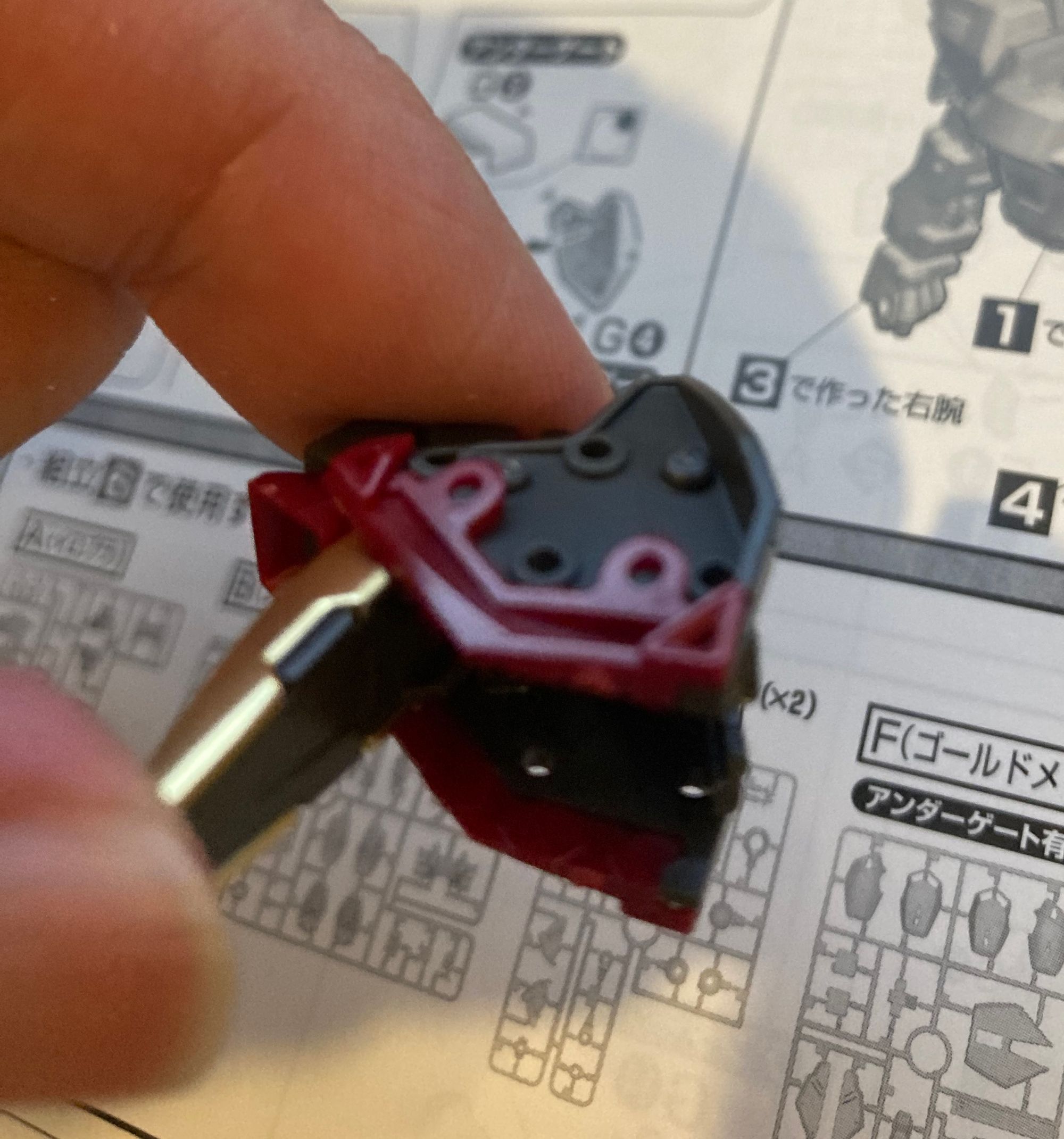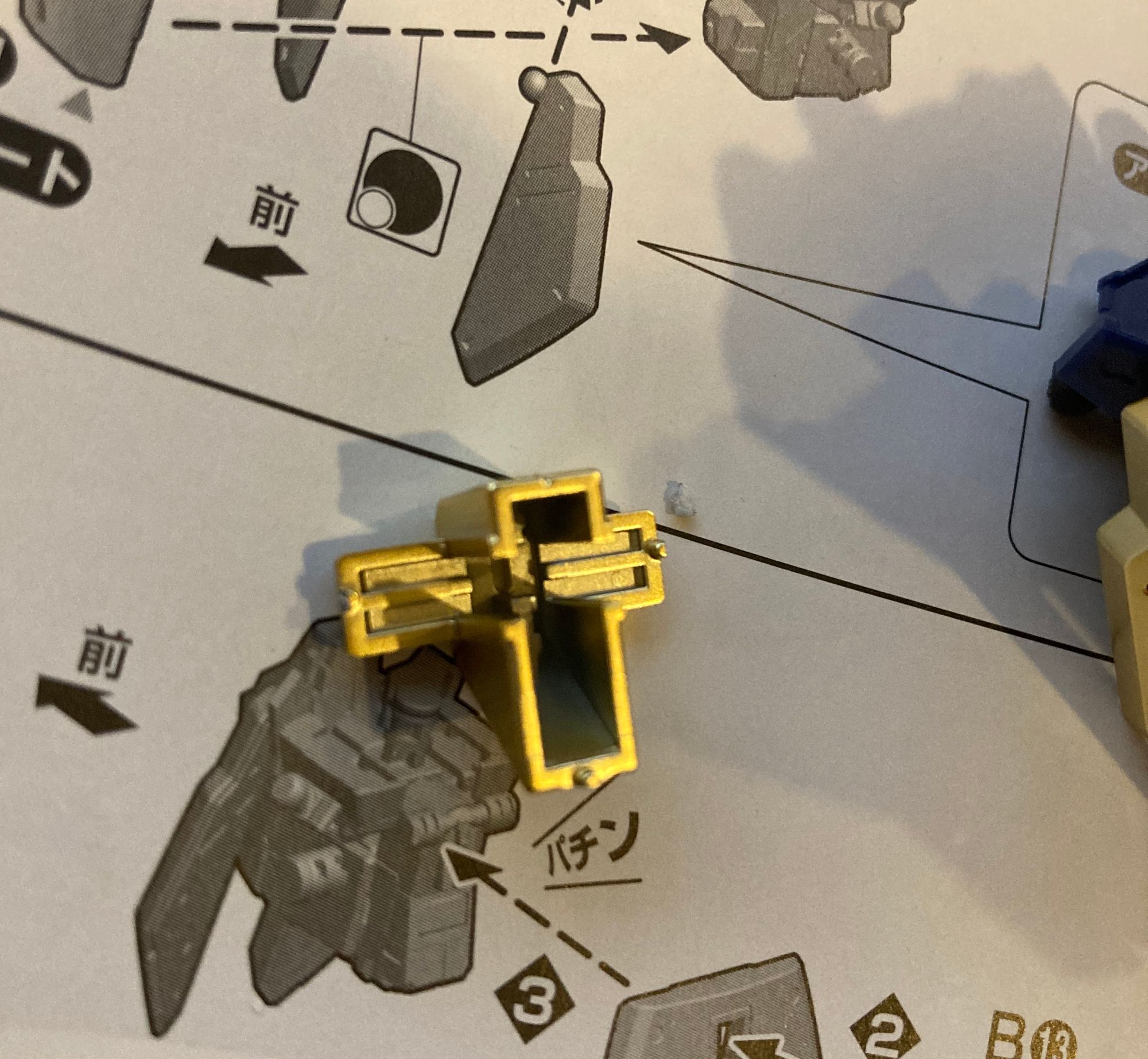March 2023 - The Hyaku Shiki is really cool

Hello friends and lovers! In this month's newsletter, I'm going to tell you about why I think the MSN-00100 Hyaku Shiki is cool. More accurately, I'm going to be talking about why the Master Grade Gunpla kit for the Hyaku Shiki is cool, and how that relates back to game design.
If you don't know what Gunpla is, they're plastic model kits for mecha from the Gundam franchise. The kits come in boxes filled with plastic runners and you have to clip out the components that make up the parts of the kit from the runners and assemble them into what the box art shows you. You (usually) don't need much more than a good pair of clippers, maybe some tweezers for small bits, and some time to put a kit together. Obviously you can go all the way and get files and sandpaper and paints and all that jazz and you can even do a lot of cool custom builds, but at its most basic, you just need to clip out the parts and the pieces can all be snap-fit together into a (wow) cool robot.
I've been building the Master Grade Hyaku Shiki as I watch the various panels from Big Bad Con Online 2023. I like having something to do with my hands while I'm watching panels, so I tend to build Gunpla. Obviously, I've been in the mode of thinking about game design as well, so I've been thinking about what I've learned from building all these models and how I relate them back to tabletop RPGs.
If you don't know what tabletop RPGs are, they're sets of rules, procedures, prompts and a method of putting them together into play that lets you play as a character or actor in the context the game serves. The games come with bits and pieces of rules that you can pull out and use to get an experience that roughly coincides with what the game describes, usually influenced by some shared storytelling tropes or genres. You usually don't need more than some pencil and paper, some friends, and some time to have a fun experience. Obviously you can go all the way and get miniatures and music and 3D terrain and all that jazz and you can even do a lot of customization to design the game into something that uniquely suits you and your context, but at its most basic, you just need to talk and imagine together with your friends.

I'll get into the Master Grade Hyaku Shiki now. For context, Master Grade means the model uses a 1/100 scale which allows it to have more detail than say a 1/144 scale High Grade. The photo above shows the Hyaku Shiki's left hand and you can see that the fingers have some articulation, while a High Grade model might just have the entire hand as a single piece of plastic and you have to swap out hands for different poses. I also want to draw your attention to the small silver/grey piece that sits above the pointer finger. This tiny piece had to be clipped out of a separate grey runner and then attached in between the gold armour piece and the dark grey pieces that make up the hand. It was a pain to make sure not to lose this little piece after I clipped it out and attached it. When you're posing the model, you'll often have the fingers splayed or have a weapon piece that might cover up this little detail. In a High Grade, this is probably just part of the gold coloured armour or might not even be there. But, for the Master Grade, someone thought it was worth the effort to put this detail in, even though it's often going to be obscured, because this little thing here is the nozzle for the sealant spray that gets used in one of the episodes of Zeta Gundam (it's been a while since I've seen it, but I'm pretty sure this is what this thing is), and it's important, damnit.


Similarly, in the above photos you can see how much plastic is used to set up the colour separation to have the little red bits in the shoulder armour. This would probably just be a sticker on a High Grade. It's hard to see in the photo, but there's also a texture on the inside of the red lining that you will likely never notice after completing the build. However, the designers opted to have that there. Again, they felt it was worth the effort. I think that's really cool! And it helps me appreciate the model and all the effort the designers put into recreating the details that matter to them.
I was also talking with some friends about games that hide lore or mechanics in them that they do not draw attention to or seemingly do not care whether players find them or not. This is usually seen in games-as-service style works like Destiny or Final Fantasy 14, but also in games like Elden Ring which have a lot to discover if you spend the effort to do so. These bits are put into the games, put into the model kits, for specific people - for the people who love delving into the detail and love appreciating the effort that goes underneath the surface, that props up the seemingly "smooth" final product. I also think about the line from the Arcane Kids manifesto, about "the purpose of gameplay is to hide secrets".
There's also the context of putting this detail into a model kit, versus putting it into a model which you might buy pre-built. The appreciation for the detail is different in each context, and when it is done in a model kit, it feels very much like the designer is letting you in on a secret as you build it into the final model.
I think about how much detail I put into the games I make, and how some things don't need to be so easily found. Obviously I want to make my games accessible as possible, but I also want to allow for that thrill of discovery, that feeling of finding something that feels like a secret. I guess "game lore" is probably the most obvious way to implement this idea, to have some details that underpin your setting that isn't so obvious, that might have to be read between the lines, or found in some weird seemingly unrelated section of the game. However, I'm also thinking of stuff like different approaches to mechanics and tricks of how to apply and combine game mechanics, like finding cool little synergies and combos that feel like exploits.
I think the trick to having these sorts of things work is to make sure that it's something that someone cares enough about - that will make some portion of people go "OH YEAH that's why that's there I've been wondering about that", and yet it has to be small enough that it's not holding up huge parts of the game. It's a tough balance between being something important enough to have people care about it, versus being unimportant enough that having it not be found isn't going to break core parts of the experience. I guess one of the things I've noticed is that my tastes have shifted towards appreciating hiding more and more supposedly "important" things, because I've been thinking differently about what's really important in games. Putting it into the context of tabletop RPGs, I want to experiment more with having players engage playfully with the game's text and rules, finding the little nooks and crannies that seem like secrets for them, rather than just as smooth, frictionless tools.
On the other hand, let's look at the armour panels for the Hyaku Shiki.

Typically on Gunpla, the pieces are connected to the plastic runners on their sides. This makes it easy to clip them off and lift the pieces out of the frames. It also usually leaves a small stress mark on the plastic, which can be quite noticeable. People who take Gunpla seriously will sand down the entire kit after clipping the parts out and repaint it so that the stress marks aren't visible. The Hyaku Shiki has a very distinctive reflective gold colour scheme. If the connectors were left at the usual sides, the stress marks would have been even more obvious. As such, the designers opted to have the connectors reach the underside of the gold armour plates, so that the stress marks would be hidden. It's not perfect, since you can still see some of the stress marks, and the serious builders will still just strip all the gold paint and repaint anyways, but this still helps the casual builders a fair bit. Its a little bit of extra effort on the part of the designers and the builder, to end up with something that looks fairly nice and clean, and I really appreciate it.
Similarly, even with going into indulgent details and hiding secrets, I still want to help players get that nice smooth sheen in their game experiences. Even if you think experienced players will just do their own thing and make it work for themselves, it's still worth taking the time to help less experienced players end up with a result they're happy with. You need to balance trusting your players with understanding that some people might be coming to your game with less experience or not wanting to do so much extra work. This might mean putting in extra effort in how you frame and explain the game, and giving GMs and facilitators for your games the right tools to enable a smoother game experience for players.
Anyway, I'm done stretching metaphors in an excuse to show you a cool plastic robot, so I'll end with a quick rundown of what I've actually been up to game design-wise:
- As I mentioned up top, Big Bad Con Online 2023 is happening and I actually moderated a panel on playtesting called "Practical Pointers for Productive (and Pleasurable) Playtesting". You can catch the Twitch VOD here, and I believe all the panels will eventually be up on YouTube later.
- I was also back on Launch Tabletop's Materialise podcast again with some old friends, again talking about (surprise, surprise) playtesting and how we run the Playtest Zero events.
- I've been working on an update to Ithaca in the Cards, called Second Expedition, which you can have a preview of here. It incorporates more prompts and attempts to streamline the steps in resolving the events, and I'm planning to have solo rules for the game too. We actually played with the expanded prompts on the Party of One episode that featured Ithaca in the Cards, but I've only now gotten to updating the rest of the game. I've still got a bunch to do with the setting prompts and the reflection prompts for the solo mode, and I'm hoping to do more playtesting for it soon.
- I've been plugging along on the secret Spectres of Brocken project, which has reached a nice milestone, so hopefully I'll be able to share some details on it soon.
That's it for now! I'm going to finish building this extremely cool Hyaku Shiki and get back into the game mines.
Plastic regards,
Aaron
